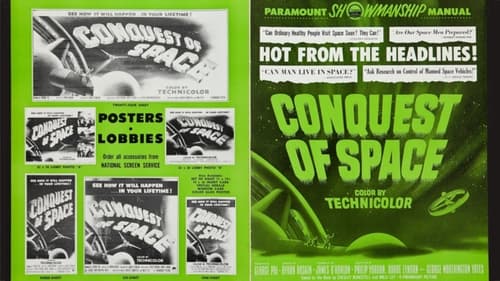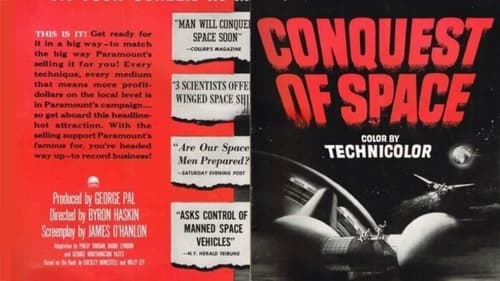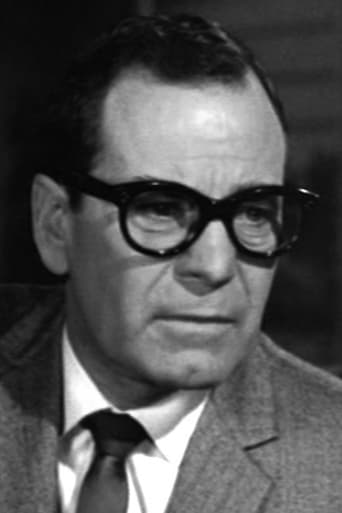CheerupSilver
Very Cool!!!
Cathardincu
Surprisingly incoherent and boring
Stevecorp
Don't listen to the negative reviews
Lightdeossk
Captivating movie !
jmillerdp
Wow, that just plain wasn't good! Interesting concept, poor execution. The movie starts out with the interesting idea of sending a group of astronauts to Mars. But, it follows that idea with odd characters spending the movie fighting with each other, lower-grade Visual Effects, and George Pal's awkwardly putting The Bible into the mix.Pal always added discussion of The Bible into his movies. Here, he does again, but it comes across as awkward and oddly used. While Pal was religious, it is interesting that he has a character turn into a religious fanatic.The movie is more about the characters clashing than about space exploration. The Visual Effects are noticeably lower grade than in Pal's previous Sci-Fi films like "War of the Worlds." It is said that Pal had his lowest budget on this, and had a Visual Effects Supervisor who was distracted by his simultaneously working on "The Ten Commandments."Overall, a disappointing conclusion to George Pal's time at Paramount. See his "Destination Moon" for a definitely better space adventure from Pal.**** (4 Out of 10 Stars)
kennethfrankel
I actually bought the Bonestell/Ley "Conquest of Space" book in 1958 - it has a few Mars images but the canals turned out to be optical illusions and Lowell's eyes may have had a problem which caused lines to appear. The book and the movie have little in common. The rockets seem to based on the German V-2, and would be fairly unstable if one would try to set one down on a surface. The Apollo LEM lander was a squat thing with 4 legs with pads - like the tobacco mosaic virus.1) At least some of the astronauts on the Mars surface had bare hands - what was the purpose then of the interesting space suits? I would like to give an idea of what the air is on Mars compared to some altitude on Earth. On Earth, at 100,000 feet up, the air pressure is 1% that at sea level. At sea level, the Earth air pressure is 1000 millibars. On Mars it varies, from the top of the big volcano to the bottom of the Hellas basin, but it averages 7-10 millibars with seasonal changes. So it is like being up really high. Would you burst like in a vacuum? Maybe or maybe not, but bare hands seem dangerous. Could a seed sprout? Hard to say. Look at what grows in Tibet, or a some parts of Antarctica. Maybe a lichen, moss, bacteria or plankton.2) The red color is due to iron in the minerals and a rust-like color results. People were obsessed with red being like blood, war, anger, etc. Rust just doesn't seem as exciting. It is more yellowish-brown than red.3) Let's go to Mars tomorrow. The Martian year is about twice that of the Earth's and satellites are being sent to Mars about every 2 years when the orbits favor a launch. The gravity on Mars is stronger than that of the Moon and weight and fuel designs would be much different. For example, many of the Apollo vehicles, landers, and gear would not support themselves on the Earth's surface. It is also one problem to go out to Mars, with the Sun pulling and slowing the spacecraft, but it another matter to come back, with the Sun speeding up the spacecraft. For example, to go into orbit around Mercury, the Messenger spacecraft is taking from 2004 to 2011, with flybys of the Earth, Venus, and Mercury to tweak the motion. Another complication the the oval orbit of Mars (and Earth) makes for a difference from 2 years and 36 days to 2 years and 78 days for opposition. An August opposition can have the 2 planets 35 million miles apart, while one in February can be 63 million miles apart (according to Willy Ley). So when the leader said that a few minutes can mean the difference between life and death, he was correct. You really have to know when to launch and how fast to go.4) Let's talk to the Wheel. They did mention the time delay when they flew away from the Wheel, but light travel time can vary from about 4 1/2 minutes to 21 minutes depending on where the Earth and Mars are as they go around the Sun. The audience would really, really bored waiting for a conversation.5) Where's the water? At the poles, along with frozen carbon dioxide.6) Why did they always have to start their trips with a seemingly maximum, crushing acceleration? 7) Why would God let us go to the Moon and not Mars? Perhaps someone could have tried to talk to the General and say something like - the solar system is ours to explore, but not beyond. That might have calmed him. How about screening people? 8) As several comments stated, how about briefing the astronauts on the basics? What were they doing for 6 months in the Wheel? Why is it dangerous to go outside the rocket ship at 20,000 MPH and not on the Wheel at 10,000 MPH or whatever the Wheel speed is? How can a person with no education be an electronics expert? That may be possible - just to use the hardware and not get into the theories. I realize that some of these inane questions were an excuse to explain to 10 year-olds in the audience some basic stuff. Neil Armstrong had a background in rendez-vous physics. Can you imagine him asking some of those stupid questions? To be fair: The Apollo simulator had good views of the stars, down to magnitude 5. The Little Dipper, part of Ursa Minor, has the North Star at the end of the handle. One of the stars in the asterism/constellation had a magnitude of 5.01 and was excluded. It was pointed out that this would really mess up the appearance of this important figure in the sky, and the missing star was put back. It is hard to get a balance between narrow vs. broad horizons.
pylgrym
Study this old seminal classic, the new Space Movie, "Sunshine" by Danny Boyle, Anderson's "Event Horizon" and "2001: A Space Odyssey" together and you'll see that George Pal was a Christian idealist, Anderson a Christian pessimist, and Boyle - a Christian optimist! Yes, old Stanley had a sardonic sense of humor. But Stanley was no Christian in any philosophical sense...Chech the similarities: "2001" owes much to "CoS"; If "CoS" had a meteor storm, "2001" had one lonely rock drifting by . . . if "CoS" had a funeral, "2001" had Frank Poole drifting away.... If "CoS" had banal and corny dialog, well... you get the idea. The themes and genre expectations of Space movies are needfully narrow; that's one reason we spacenuts love them so. ANY excuse to leave old Earth's atmosphere! Of course Stanley studied all the movies that had gone before and had the money to exercise his peculiar misanthropic oneupmanship on a grand scale. I wonder if Danny Boyle saw "CoS"? Think of the crazed father figure of CoS as the crazed HAL in '01'! or the crazed CPT of the Icarus or the Even...another thing is, in Cinemascope, "CoS" still looks as good and plays as well as Super Panavision 70's "2001"... both films will undoubtedly look dated, yes and and archaic in another 40 years, but who's to say which vision - Pal's or Kubrick's - will still be selling the most DVD 'tickets'? Something to take a deep breath, put on your space helmet and ponder - even unto the end of the world.... and the extinction of mankind...??!
Bob-45
Having produced the first "science fact/science fiction" film with "Destination Moon," George Pal should have been the perfect choice to produce "Conquest of Space." However, what Pal has assembled is a mess; for "Conquest of Space" consists largely of substandard special effects and plot implausabilities. Space is blue with stars that look like dots of white paint. When the space station moves erratically, it looks like the tiny model it is, since Pal didn't have it photographed using high speed cameras. The writers would have us believe "Sergeant Siegle" (Phil Foster), a character who would be more at home in a Jerry Lewis comedy is an "electronics genius" and that a man with virtually no knowledge of space travel would be "hand picked" to fly to Mars.I have few problems with the plot device of having the psychologically unstable "religious fanatic" commander suddenly questioning the mission and space exploration in general. Modern audiences might find this baffling or illogical; but, those who viewed "Conquest …" in 1955 were likely familiar with stories of J. Robert Oppenheimer and other scientists who worked on the atom bomb and later denounced its development. More recently, Admiral Hyman Rickover, father of the US nuclear submarine program did much the same thing, in testimony before Congress.WARNING: SPOILERS I had slightly more problems with the Martian quake that conveniently begins just before the spaceship is to blast off from Mars. While this could easily happen in "real life," it would have been more dramatically plausible had there been a few "gentle" tremors during the year the crew was stranded on the planets surface.I had a slightly bigger problem with the deliberate "spill" of hypergolic fuel by the unhinged commander. That stuff is nasty, toxic and VERY corrosive. However, even that could be overlooked because of the crew's protective space suits.The movie makes a big issue of the crew conserving water and energy during their long period of being marooned on Mars. Yet the interior of the ship is always show brightly lit. It's also virtually impossible for the crew to have survived without heat on the surface of Mars, and this information was well known at the time.END OF SPOILERS"Conquest of Space" was a missed opportunity for George Pal. I can think of only two other purely "science fact/science fiction" films, "Destination Moon" and "Riders to the Stars." "Conquest of Space" is the weakest of the three, despite having much better special effects than "Riders ..." I give it a "4".








